|
Ancient Ships
Ship Petroglyphs
Egyptian Prehistory 4500-3100 BCE
The ship petroglyphs of the Egyptian Eastern desert
The earliest historic record of seafaring ships that can be found
seem to be the Neolithic petroglyphs or rock art that are found
in the Egyptian eastern desert.
Many of these patterns have been dated to the Naqada period of
Egyptian history which covers approximately the period of 4500-3100
BCE. Modern research is currently being done to obtain datable materials
found in conjunction with the petroglyphs to more firmly establish
the dating of when the images were made..
Current dates on many sites have been derived by comparative
analysis with images found on artifacts and grave goods that are
dateable by carbon fourteen analysis. However more conclusive dating
of when these artifacts were created is yet to be made.
| One of the primary motifs of the
Eastern Desert petroglyphs. A crew rowing
the ship with a leader pointing the way. Not Dated
|
|
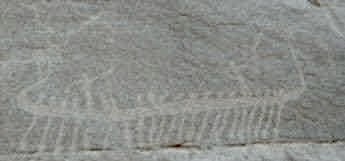
|
Early interest in the culture that produced the
petroglyphs was generated by England's archeologist Flinders Petrie
in 1920. Petrie created one of the earliest archeological
surveys of Egypt and did extensive work in Naqada.
While exploring Egypt Petrie was also instrumental
in establishing one of the first historic chronologies to help organize
the evidence of his findings. The spirit of his efforts established
Petrie as a true pioneer in the science of modern archeology and
Egyptology.
The ship petroglyphs and related artifacts
| A double ruddered sailing
vessel from Winkler's Site 26 in the Wadi Abu Wasil. Dated
to Naqada II period, 3100 BCE |
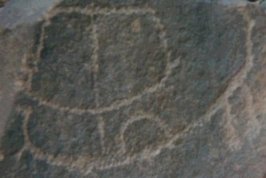
|
The Eastern desert of Egypt holds some of the
earliest surviving evidence of mans seafaring activities.
The pictorial record of these activities was recorded permanently
for posterity in the form of beautifully rendered petroglyphs of
various types of ships. These pictures made as rock art are spread
throughout the Eastern Egyptian desert on the rocks and walls of
the Wadis between the Nile river valley and the coast of the Red
Sea.
Many of these petroglyphs recreate images that are
common to other artifacts from the Naqada and prehistoric phases
of Egyptian Civilization. Grave goods from the Naqada periods reflect
the same Iconography that are found in the pertoglyphs this phenomena
has lead archeologists to conclude many of these images can be dated
to the Naqada period of Egyptian Prehistory which runs from
4500-3100 BCE.
The petroglyphs and their images are silent witness
to the central role that ships and shipping had on the prehistoric
Nile River Culture. The Nile when traveled by boat and ship is a
natural highway that runs the length of Egypt and Sudan. Understanding
the impact of the river on the lives and culture of this region
is central to understanding ancient NileValley cultures.
Within the Ships of Antiquity there is provided
a chronological study of artifacts from antiquity that specifically
carry ship motifs. The collection covers the period of 4500-100
BCE. The progression of ship technologies in antiquity can be seen
and traced from the chronological arrangement and study of these
images.
It is apparent by comparing the Abydos boat burials which can be
carbon dated to 3000 BCE that the motifs of many of these pertoglyphs
predate the Abydos boat burials.
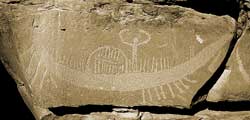
WD-3 Dancing Goddess Wadi Hammamat
The motifs within the petroglyphs suggest that the Nile valley
may have been visited by distant cultures for trade or that
the Nile Valley culture was sending regular expeditions to
other cultures. There are artifacts that contain records of Mesopotamian
motifs suggesting that travel by seas to a from the
Persian Gulf and Euphrates river occurred on a regular basis.
The exploratory imperative bringing contacts with distant cultures
to the Nile Valley is suggested by the pointing leader motif. The
reason for these contacts may have included, trade for metals, access
to the interior of Africa via boat and a leisurely trip down the
Nile to the delta and Mediterranean while having the advantage of
provisioning their ships along the way.
The motifs within the Petroglyphs and their location along ancient
trading routes both suggest the scenario that contact
with Mesopotamia occurred along seafaring routes on a regular basis.
Because there are no written records that correspond to the time
in which the petroglyphs were created we are left with interpolation
and interpretation of the artifacts themselves as the primary means
for drawing our conclusions.
For those of us who love the art of spin the interpretation of
these artifacts is prime territory for creative analysis.
What is needed for the exact dating of the pertoglyphs will be additional
archeology of eastern desert sites specifically related to the petroglyphs
and the use of dateable materials recovered at these sites for analysis.
However comparative analysis and interpolation from my personal
studies indicates the dating will be to as early as 4500 BCE.
If, as some archeologists have suggested, there are burials associated
with the Petros, finding an undisturbed burial at a petro site would
yield datable artifacts in a time capsule form. Creating such a
find or finds seems to have a lot of potential for clearing up some
of the prehistory associated with this phase of ancient seafaring.
An early survey of petroglyph sites at Kanais in
the Wadi Abbad were taken by Arthur Weigall in 1907 and then
by Hans Winkler in 1936. Wadi Barramiya sites were originally
discovered by Walter Resch in 1967 and later recorded by Gerald
Fuchs between 1985 and 1990. A more current survey
which is adding additional site locations is being taken by
The "Followers of Horus" which is an archeological team
organized by Dr. David Rohl and Dr. Toby Wilkinsen.
What can be discerned from the examination and an
analysis of the petroglyphs and related artifacts about the early
Bronze Age Egyptian Culture??
The following links are various commentaries written about the
Egyptian Eastern Desert Petroglyphs:
| Ship with mast from Wadi
Barramiya |
|
Naqada period Artifacts and Grave Goods
| 
|
Naqada II Period Pot with ship and
flamingo motifs. |
|
 |
Dancing Bird Goddess
has anthropomorphic features which is also a common
theme within the Eastern desert petroglyphs Dated to
the Naquada II period |
|

Rare predynastic boat model (Berlin)
dated to 3000 BCE
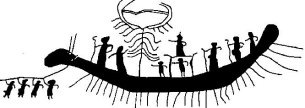
Predynastic motif with figure pointing-compare
with Wadi Mia and Wadi Kanais pointing figures.
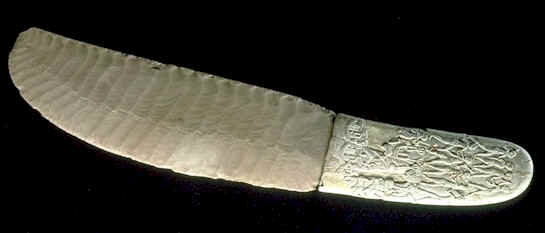
The Guebel el-Arak dagger
| Guebel el-Arak dagger
Probably from Guebel el-Arak, south of Abydos
c. 3300-3200 BC (Nagada II)
Silex blade and ivory handle (hippopotamus tooth)
L 25.5 cm; H of handle 4.5 cm
Collection of the Louvre |
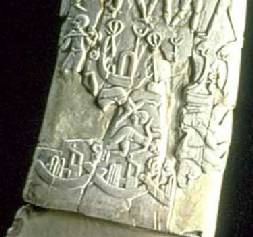
|
Similar daggers to this with finely carved handles
can be found elsewhere, but the scenes depicted here are unique.
On one side there is a battle scene on land and water; the other
side depicts animals such as lions, ibexes and dogs. On the Back
side at the top, above the knob, a man in the robes of a Sumerian
priest-king is restraining two rampant lions.
The motifs on this piece raises questions about contacts
with Mesopotamia. The animal trainer motif being Mesopotamian in
its origin. It could depict a battle between Nile Valley communities
whose differences can be seen in the design of their boats, however
it may also be an indicator that Mesopotamian traders were visiting
the Nile valley at this time in History.
What is certain is that it is an early example
of Egyptian bas-relief and it is carved with great mastery. The
silex is an example of expert flint napping with a polished
blade on one side earmarked by thin parallel groves; the handle
is covered with carving at its most refined, and characteristic
of this period of Egyptian civilization.

Ship Images from Naquada period tomb Paintings
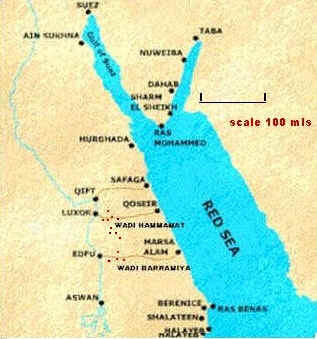
General location of the known Eastern
desert Petroglyphs.
Surveys of the Rock art show they are generally distributed along
routes that were used for trade. It can be concluded the survey
has yet to find all sites and that their is much to be discovered
in conjunction with the Petroglyphs.
|
